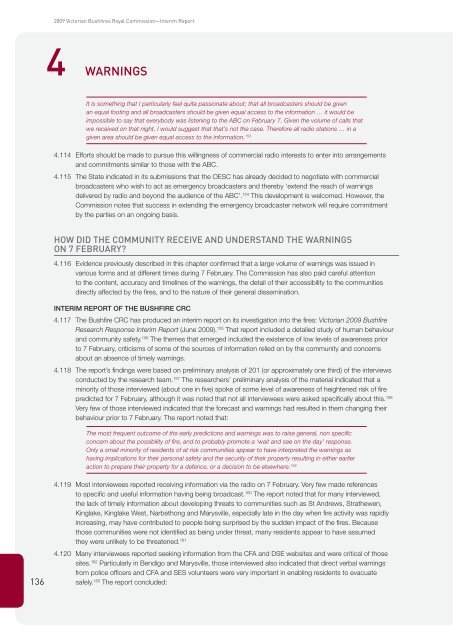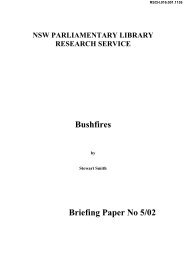Chapter 4 - Warnings - 2009 Victorian Bushfires Royal Commission
Chapter 4 - Warnings - 2009 Victorian Bushfires Royal Commission
Chapter 4 - Warnings - 2009 Victorian Bushfires Royal Commission
You also want an ePaper? Increase the reach of your titles
YUMPU automatically turns print PDFs into web optimized ePapers that Google loves.
<strong>2009</strong> <strong>Victorian</strong> <strong>Bushfires</strong> <strong>Royal</strong> <strong>Commission</strong>—Interim Report<br />
4 WARNINGS<br />
It is something that I particularly feel quite passionate about; that all broadcasters should be given<br />
an equal footing and all broadcasters should be given equal access to the information … it would be<br />
impossible to say that everybody was listening to the ABC on February 7. Given the volume of calls that<br />
we received on that night, I would suggest that that’s not the case. Therefore all radio stations … in a<br />
given area should be given equal access to the information. 153<br />
4.114 Efforts should be made to pursue this willingness of commercial radio interests to enter into arrangements<br />
and commitments similar to those with the ABC.<br />
4.115 The State indicated in its submissions that the OESC has already decided to negotiate with commercial<br />
broadcasters who wish to act as emergency broadcasters and thereby ‘extend the reach of warnings<br />
delivered by radio and beyond the audience of the ABC’. 154 This development is welcomed. However, the<br />
<strong>Commission</strong> notes that success in extending the emergency broadcaster network will require commitment<br />
by the parties on an ongoing basis.<br />
HOW DID THE COMMUNITY RECEIVE AND UNDERSTAND THE WARNINGS<br />
on 7 february?<br />
4.116 Evidence previously described in this chapter confirmed that a large volume of warnings was issued in<br />
various forms and at different times during 7 February. The <strong>Commission</strong> has also paid careful attention<br />
to the content, accuracy and timelines of the warnings, the detail of their accessibility to the communities<br />
directly affected by the fires, and to the nature of their general dissemination.<br />
Interim report of the Bushfire CRC<br />
4.117 The Bushfire CRC has produced an interim report on its investigation into the fires: <strong>Victorian</strong> <strong>2009</strong> Bushfire<br />
Research Response Interim Report (June <strong>2009</strong>). 155 That report included a detailed study of human behaviour<br />
and community safety. 156 The themes that emerged included the existence of low levels of awareness prior<br />
to 7 February, criticisms of some of the sources of information relied on by the community and concerns<br />
about an absence of timely warnings.<br />
4.118 The report’s findings were based on preliminary analysis of 201 (or approximately one third) of the interviews<br />
conducted by the research team. 157 The researchers’ preliminary analysis of the material indicated that a<br />
minority of those interviewed (about one in five) spoke of some level of awareness of heightened risk of fire<br />
predicted for 7 February, although it was noted that not all interviewees were asked specifically about this. 158<br />
Very few of those interviewed indicated that the forecast and warnings had resulted in them changing their<br />
behaviour prior to 7 February. The report noted that:<br />
The most frequent outcome of the early predictions and warnings was to raise general, non specific<br />
concern about the possibility of fire, and to probably promote a ‘wait and see on the day’ response.<br />
Only a small minority of residents of at risk communities appear to have interpreted the warnings as<br />
having implications for their personal safety and the security of their property resulting in either earlier<br />
action to prepare their property for a defence, or a decision to be elsewhere. 159<br />
136<br />
4.119 Most interviewees reported receiving information via the radio on 7 February. Very few made references<br />
to specific and useful information having being broadcast. 160 The report noted that for many interviewed,<br />
the lack of timely information about developing threats to communities such as St Andrews, Strathewen,<br />
Kinglake, Kinglake West, Narbethong and Marysville, especially late in the day when fire activity was rapidly<br />
increasing, may have contributed to people being surprised by the sudden impact of the fires. Because<br />
those communities were not identified as being under threat, many residents appear to have assumed<br />
they were unlikely to be threatened. 161<br />
4.120 Many interviewees reported seeking information from the CFA and DSE websites and were critical of those<br />
sites. 162 Particularly in Bendigo and Marysville, those interviewed also indicated that direct verbal warnings<br />
from police officers and CFA and SES volunteers were very important in enabling residents to evacuate<br />
safely. 163 The report concluded:
















